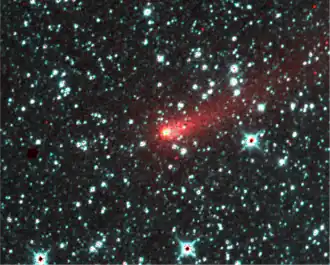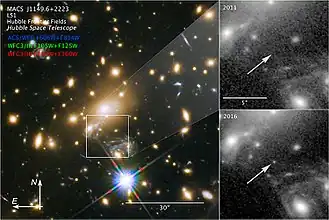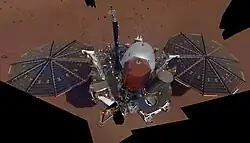C/2017 T1 (Heinze)
 Infrared image of Comet Heinze taken by NEOWISE on 9 January 2018 | |
| Discovery[1][2] | |
|---|---|
| Discovered by | Aren N. Heinze |
| Discovery site | ATLAS–MLO (T08) |
| Discovery date | 2 October 2017 |
| Designations | |
| CK17T010[2] | |
| Orbital characteristics[3] | |
| Epoch | 14 December 2017 (JD 2458101.5) |
| Observation arc | 262 days |
| Earliest precovery date | 28 September 2017 |
| Number of observations | 1,005 |
| Perihelion | 0.581 AU |
| Eccentricity | 1.00034 |
| Inclination | 96.83° |
| 102.32° | |
| Argument of periapsis | 96.92° |
| Last perihelion | 21 February 2018 |
| Earth MOID | 0.014 AU |
| Jupiter MOID | 3.032 AU |
| Physical characteristics[4] | |
| Comet total magnitude (M1) | 11.9 |
| Comet nuclear magnitude (M2) | 17.0 |
| 8.2 (2017 apparition) | |
C/2017 T1 (Heinze) is a hyperbolic comet that passed closest to Earth on 4 January 2018 at a distance of 0.22 AU (33 million km).[5]
Discovery and observations
It was discovered on 2 October 2017 by Aren N. Heinze of the University of Hawaiʻi, using the 0.5-m Schmidt telescope at the Mauna Loa Observatory used for the Asteroid Terrestrial-impact Last Alert System (ATLAS).[1][6] Perihelion was reached on 21 February 2018, and it was expected peak magnitude about 8.8.[7] However, this intrinsically faint comet began to disintegrate around this time.[8][9] It was last observed as a dim 16th-magnitude object on 23 April 2018.[4]
Observation path
-
 Path of C/2017 T1 (Heinze) in sky. It is closest to Earth on Jan 4, 2018 and passed over the north pole as it approaches perihelion.
Path of C/2017 T1 (Heinze) in sky. It is closest to Earth on Jan 4, 2018 and passed over the north pole as it approaches perihelion.
References
- ^ a b D. W. Green (16 October 2017). "Comet C/2017 T1 (Heinze)". Central Bureau for Astronomical Telegrams. 4444. Bibcode:2017CBET.4444....1S.
- ^ a b G. V. Williams (16 October 2017). "MPEC 2017-U15 : Comet C/2017 T1 (Heinze)". www.minorplanetcenter.net. Minor Planet Center.
- ^ "C/2017 T1 (Heinze) – JPL Small-Body Database Lookup". ssd.jpl.nasa.gov. Jet Propulsion Laboratory. Retrieved 15 January 2025.
- ^ a b "Observation list for C/2017 T1". COBS – Comet OBServation database. Retrieved 12 January 2025.
- ^ D. Dickinson (2018). "Here Comes Comet Heinze for the Holidays". Universe Today. Archived from the original on 6 January 2018. Retrieved 15 January 2025.
- ^ S. Yoshida. "C/2017 T1 (Heinze)". www.aerith.net. Retrieved 15 January 2025.
- ^ B. King (1 November 2017). "Comet Heinze (C/2017 T1): A Binocular Comet for the New Year?". Sky & Telescope. Retrieved 4 January 2018.
- ^ "Comets 631–640". The Earthrise Institute. 9 April 2018. Retrieved 16 January 2025.
- ^ M. Mattiazzo. "Other Interesting Fainter Comets". Southern Comets Homepage. Retrieved 16 January 2025.
External links
Wikimedia Commons has media related to C/2017 T1 (Heinze).
- C/2017 T1 at the JPL Small-Body Database

.png)

